Russia using electronic warfare to cloak its actions in Syria from Isis and Nato

Fed up of the West's indecisiveness on dealing with the ongoing situation in Syria, Russia is now providing direct military air support to Syria, and it is using electronic warfare to jam Islamic State's (IS) communications, as well as to prevent Nato from detecting what it is up to, according to an electronic warfare expert.
Electronic warfare is the ability to manipulate the electromagnetic spectrum in order to sense where enemy targets are so that you can attack the enemy first, or to prevent the enemy from attacking you. Examples of things you can do with electronic warfare include communications jamming, radar jamming, reconnaissance and countermeasures using infrared, radio and electro-optical frequencies.
On 5 October, Russian military Krasukha-4, its mobile, ground-based electronic warfare systems, were spotted in Syria. The Krasukha-4 is a broadband multifunctional jamming station that is based on a BAZ-6910-022 four-axle-chassis and is able to neutralise low-Earth orbit (LEO) spy satellites such as the US Lacrosse/Onyx series, airborne surveillance radars and radar-guided ordinance at ranges between 150km-300km.
According to David Stupples, a Professor of Electrical and Electronic Engineering and Director of Electronic Warfare at City University London, the Krasukha-4 is being used by the Russian military to deny IS surveillance information and radio communications.
Russia against all of Assad's enemies
Russia has long been supporting Syria's president Bashar al-Assad, supplying arms and training to Syrian forces. However, the issue is that Russia isn't just there to get rid of Isis, but all of Assad's enemies, which include all the rebel groups who oppose his rule.

This contravenes with Nato's objective, which has been to also use electronic warfare to gather information about and hinder IS, and give it to friendly rebel forces. So, both Nato and Russia are now turning their state-of-the-art technologies against each other, on top of dealing with IS.
"Russia is aware that NATO surveillance assets are able to monitor all Syrian-based Russian military aircraft activity, including the rebel groups it is targeting, locations and weapons used. Some of these rebel groups are directly supported by the US and its allies which may result in Russia becoming in direct political conflict with Nato," Stupples writes in a piece for The Conversation.
"To avoid being spied on, Russia needs to blind the eyes and silence the ears of Nato reconnaissance and intelligence-gathering assets so its actions are not open to close scrutiny."
The problem is that the Krasukha-4 has already proved to be highly effective when used against Ukrainian forces in Donbas, according to Lt General Hodges, the commander of US Army Forces Europe.
"The quality of the electronic warfare [EW] capability that Russians have employed in eastern Ukraine, this is not something that you can create in the basement of your home," Hodges told Defense News in March.
"The Russians have continued to move forward with their EW modernisation. They have demonstrated the ability to completely shut down everything the Ukrainians are using in terms of communications."
A New Cold War?
Stupples says that the Krasukha-4 will definitely prove to be a thorn in the side of Nato: "Its surveillance systems will not only be able to monitor Nato aircraft movement over Syria but also the types, and from its intelligence it will know the frequencies used and signal characteristics present – Lacrosse satellites and AWACS operate in S-band, Sentinel (and similar) in X-band, and drones in J-band.
"Lacrosse/Onyx satellite positions are continually tracked by Russia. With this intelligence detail the Krasukha-4 can be programmed to engage in order to deny or disrupt Nato intelligence gathering."

On the plus side at least Nato forces have electronic counter counter measures (ECCM) that they can use against Russia, which will require Nato to dodge Russian jamming signals by jumping onto other frequencies, or pointing its antennas away from the jamming source.
"Of course, it would also be possible for Nato to jam the Russian surveillance radar, denying them of identification and positioning of Nato aircraft – but this would really ramp up the war of words with Vladimir Putin," Stupples concludes, adding that Russia's results using the Krasukha-4 against Nato will help it sell the system to other governments.
"We must also accept that the Krasukha-4 EW system is an essential part of the defence of Russian forces at the Latakia airfield in Syria and this must not be denied them."
© Copyright IBTimes 2024. All rights reserved.






